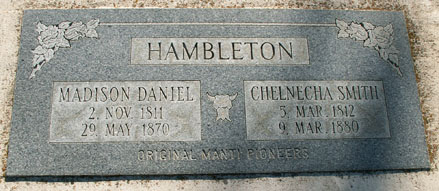---------------------------------------------------------------
February 11th, 1846: I started with the pioneer Camp for Sugar Creek in Iowa. I left my family in Nauvoo, which was very painful to my feelings as I had left but a short allowance of provisions. I stayed with the camp on Sugar Creek until it started West. I then went back to Nauvoo to prepare to leave with the Saints. Made two wagons, one for myself, and left the City for the Pioneer Camp.
May 12th, 1846: we started out with 100 lbs. of flour, 1-1/2 bu. of parched corn meal. We sold all of our feather beds except two pillows, left all our furniture standing in the house. Made our load as light as possible so that one yoke of two year old steers could draw it, trusting in the Lord and His providential hand for our support. We traveled west some 75 miles when we overtook Major Jefferson Hunt with 15 teems, traveled with him two miles north of the town of Bloomfield. Here I was arrested by a court from the Missouri River on a charge of larceny. I went back and was lodged in Fort Madison Prison, they refusing to take any ‘Mormon bail’. I stayed in 13 days and was discharged without a trial. I had left my family standing on the prairie all alone, except for one young man by the name of John O. Angus, who traveled with me. Before I arrived to where I had left my family, my wife gave two three year old steers and my rifle for a large yoke of oxen, and had gone on with another company under Captain Andrew Perkins. I overtook them at the head of the Charedon River and on the 25, June we arrived at Mt. Pisgah. Stayed until the 1st of July when we started for Council Bluffs where we arrived on the 10 of July.
August 8th, 1846: moved to Cutler Park for winter quarters. Here we met the head chief of the Amshaw Indians, whose name was Elk, with about all of his warriors. All manifested friendship and were willing for us to stay.
Sept. 10th, 1846: President Brigham Young chose myself and nine others to take the herd of cattle for the whole camp. Oct. 26th, we gave up a part of the herd and went to work to hunt for the stray cattle and take them to the creek beds up the river and herd them all winter. We made up a herd of some 800 head. We were troubled a great deal with the Indian’s killing them. When we delivered the stock to their owners we got partly paid for our services so we gathered a few dollars in money. Went down the river about 176 miles bought 1200 lbs. of flour and returned to Winter Quarters.
May 4, 1849: myself with nine others, was selected by Pres. Young to go to the North Platte Ferry and attend to it and cross the emigrations. This we did, realizing $625 each in money, merchandise and stock. Got home August 14th.
-----------------------------------------------------------------------------------
The rest of the entries tell of dealing with the Indians and their numerous raids. Madison Daniel Hambleton died May 29, 1870 at Manti, Sanpete County, Utah and is buried there. He was 58 years old when he died. His life seemed to be a mirror of the early history of the church. He lived through trials, tribulations and heartbreak. And yet, not once in his writings is there a trace of murmur, regret or denouncing the Brethren. His faith sustained him through. He is, indeed, a good example for us in this time.

As a relative of Madison D. Hambleton, I was interested to find this three part piece about him, and especially the photograph of him. I have wondered about the appearance of this rather colorful member of the family.
ReplyDeleteI too am a descendant of Madison and his 3rd wife Clarinda Green.I am not certain as to how this happened, but the death year of 1870 is incorrect as he died 20 May 1869. His will was probated in Dec of 1869 in Manti, Sanpete, Utah.
ReplyDelete